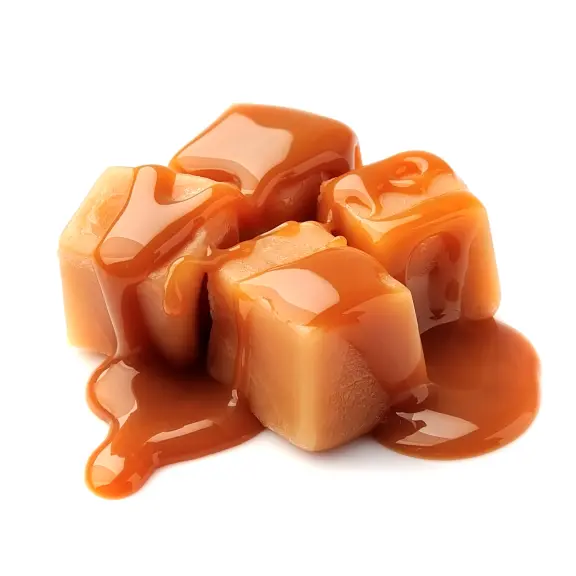
What is the trick to making caramel?
Caramel is a well-known treat. with its rich flavour and smooth texture, it’s a favourite in desserts, candies, and more. But have you ever wondered how it’s made? Today, we’ll uncover the simple yet fascinating process behind making caramel.
The art of making caramel: Tips & Tricks
Caramelization is the magic that happens when sugars and proteins are heated. The reaction between the sugars and proteins is called the Maillard reaction. Caramelization in the confectionery industry often takes place at temperatures of 115-128°C. First, the sugar turns into a clear liquid. As it continues to heat, the liquid turns golden, then amber. This transformation is called caramelization.
The thermal processing of amino acids and sugars produces a mixture of complex compounds. These new compounds are what give caramel its unique taste and colour. The flavour evolves from sweet and mild to rich and slightly bitter, with notes of butter and toast.
Making caramel requires a bit of patience and attention. You need to watch the time and temperature closely and stir it carefully to avoid burning. But once you master this process, you can create a variety of delicious treats.
Key ingredients for perfect caramel
Creating caramel on an industrial scale involves more than just sugar, milk, and heat. Here are the key ingredients used to produce caramel:
- Sugar and Syrup: The primary ingredients in caramel production. Both white granulated sugar (sucrose) and glucose syrup are commonly used. Glucose syrup supplies the small sugars for the Maillard reaction, the large molecules to prevent crystallization, and ensures a consistent texture. All the sugars bring sweetness and viscosity to the caramel.
- Water: Essential for dissolving the sugar and controlling the caramelization process. Water helps to evenly distribute heat, and boiling the water off to the required dry solids provides the required texture, whether creating a hard or soft caramel.
- Milk and Cream: These dairy products add richness and a creamy texture to the caramel. They also contribute to the Maillard reaction, which enhances flavour and colour.
- Butter and fats: Add a buttery flavour and smoothness to the caramel. Butter also aids in creating a soft, creamy texture or a more hard bite.
- Salt: Enhances the flavour profile by balancing the sweetness and adding depth to the caramel.
- Flavourings: Natural or artificial flavourings, such as vanilla, are added to enhance the taste of the caramel.
- Emulsifiers: Ingredients like lecithin are used to ensure a uniform mixture and prevent separation of fats and liquids.
These ingredients are combined in precise proportions and heated under controlled conditions to produce consistent, high-quality caramel on an industrial scale. The process involves careful monitoring and adjustments to ensure that the caramel develops the desired flavour, colour, and texture.
Techniques for achieving the perfect caramel
Producing caramel on a large scale requires advanced techniques to ensure consistency and quality. The first step is weighing and blending all the ingredients required for cooking the caramel, dosing liquid ingredients and powders into a vessel with optimal stirring capabilities. The next two important steps are keeping the mass warm to develop the caramel colour and flavour and cooking to the required dry solid content.
In the Maillard reactor, the caramel ingredients are heated to the required temperature and kept at this temperature until the required colour and flavour are developed. This process could take 10-40 minutes. This process can be accelerated by applying pressure. High pressure limits boiling and creates higher cooking temperatures. Temperature control is crucial in this Maillard reactor, maintained by automated systems to keep the sugar mixture at the ideal caramelization temperature (115°C to 128°C / 239°F to 262°F).
Reaching the right dry solid content can be achieved by batch cooking or continuous cooking. Continuous cookers cook the mass within minutes to its required dry solid content, and it is a closed system which allows for accurately controlled evaporation.
After cooking, the heat-sensitive ingredients like flavourings or inclusions can be mixed in. Now the cooling and forming process can start. Rapid cooling on cooling belts or in tunnels halts the process and stabilizes the texture.
Automation and monitoring systems control the entire production process, from ingredient feeding to cooking and cooling, ensuring consistency and reducing human error.
Troubleshooting common caramel issues
Producing caramel involves several potential errors that can affect quality and consistency.
Overheating the caramel mixture could result in a too-dark colour and a bitter taste. To prevent this, precise temperature control using automated systems is crucial, maintaining the ideal caramelization range as stated earlier. Unwanted sugar crystals, causing a grainy texture, can form if crystallization occurs. This can be prevented by incorporating glucose syrup and maintaining a clean production environment.
Inconsistent mixing of fats can cause phase separation, resulting in an uneven texture. High-shear mixers ensure thorough emulsification, and adding emulsifiers like lecithin further stabilizes the mixture. Variations in cooling rates can lead to inconsistent textures, so rapid and uniform cooling on belts or in tunnels is essential. Ensuring even cooling during this stage can help maintain a consistent texture. Overcooking or improper ingredient ratios can lead to too hard or too soft a texture, so precise recipe adherence and automated monitoring of ingredient proportions and cooking times are required. Addressing these errors with precise control and advanced techniques ensures consistent, high-quality caramel production.
Conclusion
Crafting caramel seems easy upfront, but creating the same quality caramel each time requires a well-controlled process. Mastering the technique of making caramel opens a world of possibilities; imagine adding it to candy bars, other confectionery delights, or applying it on cookies or other bakery products. And what about desserts, ice cream, and sweet coffee beverages?
The food technologists at Tanis have the knowledge to guide you through the process of making great caramel. Schedule an appointment to discuss the possibilities together. To give you a better idea about the necessary equipment to make caramel, we have written an article on our website as well.


